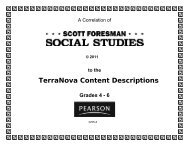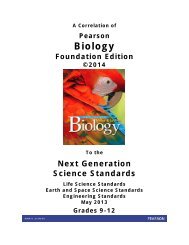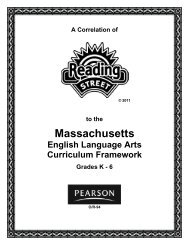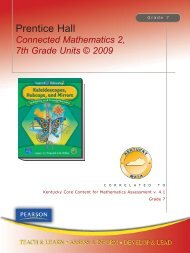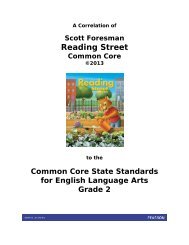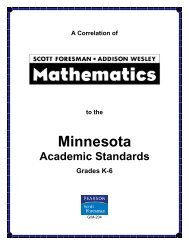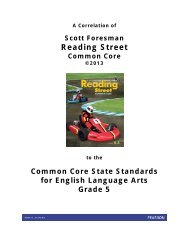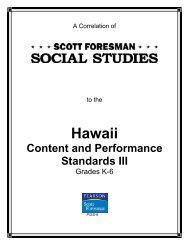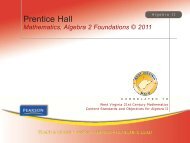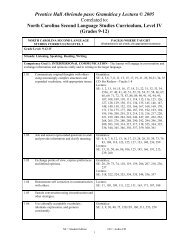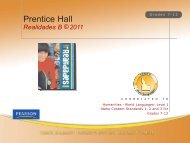Miller & Levine Biology - Pearson
Miller & Levine Biology - Pearson
Miller & Levine Biology - Pearson
Create successful ePaper yourself
Turn your PDF publications into a flip-book with our unique Google optimized e-Paper software.
A Correlation of<strong>Miller</strong> & <strong>Levine</strong> <strong>Biology</strong>, ©2014to the Next Generation Science Standards, May 2013Grades 9-12HS-LS3 Heredity: Inheritance and Variation of TraitsHS-LS3 Heredity: Inheritance and Variation of TraitsStudents who demonstrate understanding can:HS-LS3-1. Ask questions to clarify relationships about the role of DNA and chromosomes in coding the instructions forcharacteristic traits passed from parents to offspring. [Assessment Boundary: Assessment does not include the phases of meiosis or the biochemicalmechanism of specific steps in the process.]MILLER & LEVINE BIOLOGY: In Lesson 7.2 (p. 197), students learn that the nucleus of a cell contains chromosomes with DNA. In Lesson10.2 (pp. 279–280), students learn about the role of chromosomes in cell division. Lesson 12.1 (pp. 342–343) provides a general descriptionof the role of DNA. Lesson 12.2 (pp. 344–348) describes the structure of DNA. In Lesson 13.2 (pp. 366–367), students learn how theinstructions for characteristic traits (the genetic code) are stored in DNA.Students ask questions about the role of DNA and chromosomes in the inheritance of characteristic traits: Students write a series ofquestions about one component of the process that translates the genetic code into proteins (Q4, p. 371). Students write questions aboutthe transmission of human traits (In Your Notebook, p. 396).HS-LS3-2. Make and defend a claim based on evidence that inheritable genetic variations may result from: (1) new geneticcombinations through meiosis, (2) viable errors occurring during replication, and/or (3) mutations caused by environmentalfactors. [Clarification Statement: Emphasis is on using data to support arguments for the way variation occurs.] [Assessment Boundary: Assessment does not include the phasesof meiosis or the biochemical mechanism of specific steps in the process.]MILLER & LEVINE BIOLOGY: Students are introduced to the process of DNA replication in Lesson 12.3 (pp. 350–353) and mutations inLesson 13.3 (pp. 372–376). Lesson 17.1 (pp. 482–486) connects genetics to evolutionary theory. Lesson 17.2 (pp. 487–492) focuses on themechanisms by which genetic variation is introduced into populations. Students revisit the effect of mutations on evolution in Lesson 17.4(pp. 498–500).Students defend claims based on evidence about the causes of inheritable genetic variations: Students write an argument to support aclaim about antibiotic use as a cause of genetic variation in bacteria (p. 493). Students use evidence to choose the correct hypothesis aboutthe evolution of two fish populations (Analyzing Data, p. 500). Students defend the claim that evolution is ecology over time (Q38, p. 506).HS-LS3-3. Apply concepts of statistics and probability to explain the variation and distribution of expressed traits in apopulation. [Clarification Statement: Emphasis is on the use of mathematics to describe the probability of traits as it relates to genetic and environmental factors in theexpression of traits.] [Assessment Boundary: Assessment does not include Hardy-Weinberg calculations.]MILLER & LEVINE BIOLOGY: The term probability is defined in Lesson 11.2 (p. 313) in relation to genetic crosses. Exceptions to Mendel’sprinciples are discussed in Lesson 11.3 (pp. 319–320) as is how the environment can affect the expression of genes (p. 321). Lesson 14.1(pp. 392–397) focuses on the variation of traits in humans.Students apply concepts of statistics and probability to the variation of traits: Students use probability to explore the inheritance ofheight in plants (Q2b, p. 318). Students use a Punnett square to show the results of a two-factor cross and explain why the actual resultsdo not match the expected results (Q1 and Q2, p. 331). Students use probability to explain the inheritance of smooth coats in guinea pigs(Q12, p. 332). Students use data to draw conclusions about the inheritance of eye color in fruit flies (Analyzing Data, p. 334).The performance expectations above were developed using the following elements from the NRC document, A Framework for K-12 Science Education:Science and Engineering Practices Disciplinary Core IdeasAsking Questions and Defining ProblemsLS1.A: Structure and FunctionAsking questions and defining problems in 9-12 builds on •All cells contain genetic information in the form of DNAK-8 experiences and progresses to formulating, refining, molecules. Genes are regions in the DNA that contain theand evaluating empirically testable questions and design instructions that code for the formation of proteins.problems using models and simulations.(secondary to HS-LS3-1) (Note: This Disciplinary Core•Ask questions that arise from examining models or a Idea is also addressed by HS-LS1-1.)theory to clarify relationships. (HS-LS3-1)SE: Q4 (p. 371); In Your Notebook (p. 396)SE/TE: The Nucleus (p. 197); Genes andAlleles (p. 310); The Role of DNA (pp. 342–343); The Genetic Code (pp. 366–367)Crosscutting ConceptsCause and Effect•Empirical evidence is required to differentiate betweencause and correlation and make claims about specificcauses and effects. (HS-LS3-1),(HS-LS3-2)SE: Q6 (p. 332); Q28 (p. 334); Q8 (p. 356);Use Science Graphics (p. 358); AnalyzingData (p. 381); Q17 (p. 386); Q15 (p. 413);Analyzing Data (p. 414)TE: Transfer Performance Task (p. 330);Assess and Remediate, ConstructingExplanations (p. 336b); How Science Works(p. 370)SE = Student Edition; TE = Teacher’s Edition; LMA = Lab Manual A 13



